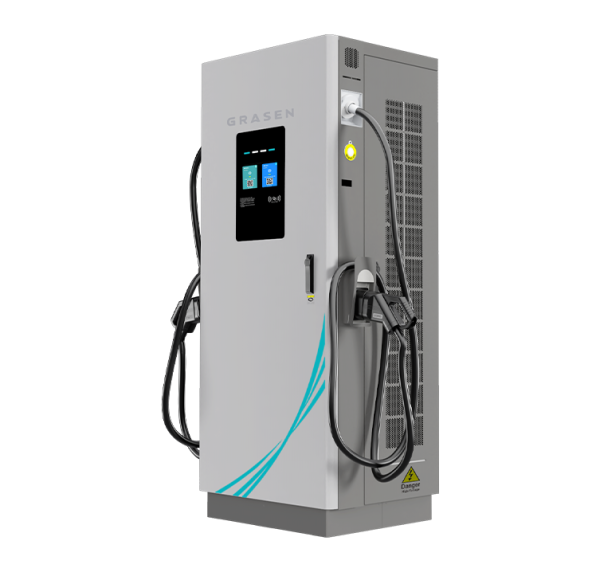With the growing popularity of electric vehicles (EVs) across the globe, the need for efficient and fast charging solutions has never been more critical. One of the most significant innovations in this space is the DC Fast Charger (DCFC). These chargers are transforming the EV charging landscape by drastically reducing charging times, making long-distance electric vehicle travel more practical and appealing.
What is a DC Fast Charger?
A DC Fast Charger is a type of electric vehicle charger that uses direct current (DC) to rapidly charge an EV’s battery. Unlike traditional AC chargers, which deliver alternating current (AC) to the vehicle and rely on the vehicle’s onboard charger to convert it into DC, DC Fast Chargers supply DC power directly to the battery. This allows the battery to charge much faster, bypassing the need for internal conversion and significantly reducing charging times.
Key Features of DC Fast Chargers
- Speed and Efficiency: DC Fast Chargers can deliver charging power between 50 kW and 350 kW, depending on the charger model and the EV’s capabilities. For comparison, a typical Level 2 AC charger operates at 7.2 kW, meaning a DC Fast Charger can charge an EV battery in a fraction of the time. For instance, many modern EVs can charge up to 80% in just 30 minutes with a DC Fast Charger.
- Voltage Range: DC Fast Chargers typically operate with a voltage range between 200V and 1,000V. This is ideal for quickly delivering the power needed to charge a battery in a shorter period. The higher the voltage, the quicker the charge—though it also depends on the vehicle’s compatibility with the charger.
- Global Standards: There are different standards for DC Fast Charging around the world, the most common being the CHAdeMO, CCS (Combined Charging System), and Tesla Supercharger networks. CHAdeMO is widely used in Japan and Europe, while CCS is becoming the dominant standard in North America and Europe. Tesla has its proprietary Supercharger network, which is exclusive to Tesla vehicles but also supports DC Fast Charging.
- Accessibility: DC Fast Charging stations are often located along highways, in commercial areas, or in dedicated EV charging stations to support long-range EV travel. These stations are crucial for drivers who need to quickly recharge during a road trip or while in transit.
Benefits of DC Fast Charging
- Reduced Charging Time: The most significant advantage of DC Fast Chargers is their ability to charge EVs in a fraction of the time compared to regular chargers. This makes EVs more convenient for users, encouraging broader adoption.
- Facilitates Long-Distance Travel: With the ability to charge a vehicle in as little as 20–30 minutes, DC Fast Chargers make long-distance road trips feasible for EV owners. Travelers can stop for a quick charge, refuel, and continue their journey without the long delays associated with slower chargers.
- Increased Adoption of Electric Vehicles: As charging infrastructure improves, particularly with the expansion of DC Fast Chargers, more consumers are likely to embrace EVs, knowing they can conveniently charge their vehicles on the go. This helps reduce range anxiety—the fear of running out of battery power during a trip.
- Energy Efficiency: DC Fast Chargers are designed to efficiently transfer power to the battery. This efficiency can help reduce energy waste, ensuring that a significant portion of the power supplied is effectively stored in the vehicle’s battery.
Challenges and Considerations
Despite the benefits, there are some challenges with the widespread implementation of DC Fast Chargers:
- Infrastructure and Cost: Installing and maintaining DC Fast Chargers can be expensive due to the high power requirements and the complexity of the technology. This means that installation is often concentrated in urban centers and along major highways. Expanding this infrastructure is crucial for supporting the growing number of electric vehicles on the road.
- Battery Health: While DC Fast Charging is convenient, it can generate more heat and stress the battery over time, potentially leading to quicker degradation of the battery’s capacity if used too frequently. Many EV manufacturers have incorporated technologies to manage battery temperature and prevent overcharging, but this remains an area of concern for some users.
- Standardization Issues: The existence of multiple charging standards across different regions and automakers can lead to compatibility issues. While most modern EVs use CCS or CHAdeMO, earlier models and some vehicles from specific manufacturers might not support the newest chargers, leading to inconvenience for drivers.
- Power Grid Demand: DC Fast Chargers require substantial amounts of electrical power, and as the number of EVs on the road increases, the demand on local power grids will also rise. To manage this, utilities will need to ensure they can provide enough power without overwhelming the grid.
The Future of DC Fast Charging
The future of DC Fast Charging looks promising as advancements in battery technology, charging equipment, and power distribution systems continue to evolve. Key trends to watch include:
- Ultra-Fast Charging: Some upcoming chargers are capable of delivering over 350 kW of power, enabling EVs to charge in as little as 15 minutes. These chargers are still in the early stages but will play a pivotal role in enhancing convenience.
- Wireless Charging: As research into wireless charging (inductive charging) advances, it’s possible that future DC Fast Charging systems may eliminate the need for physical connectors altogether, making charging even more accessible.
- Smart Charging Networks: With the integration of smart technologies, future charging networks may optimize power distribution based on demand, location, and the type of vehicle, further improving the user experience.
Conclusion
DC Fast Charging is a game-changer in the electric vehicle ecosystem. By providing fast, efficient, and reliable charging, it enhances the practicality of electric vehicles and makes them a more viable alternative to traditional combustion engine vehicles.
